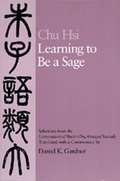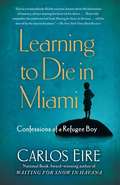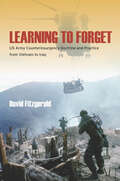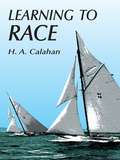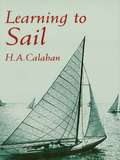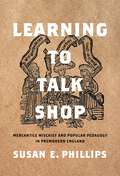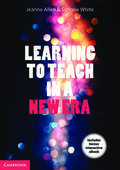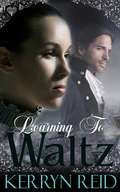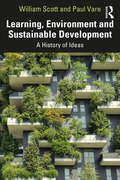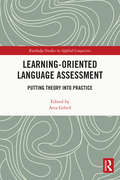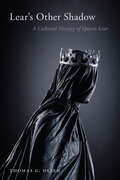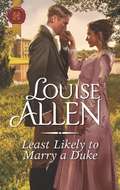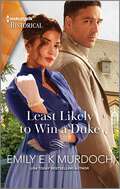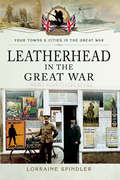- Table View
- List View
Learning to Be a Sage: Selections from the Conversations of Master Chu, Arranged Topically
by Hsi Chu Daniel K. GardnerDaniel Gardner's translation of the teachings of Chu Hsi (1130-1200)--a luminary of the Confucian tradition who dominated Chinese intellectual life for centuries focuses on Chu Hsi's passionate interest in education and its importance to individual development.
Learning to Die in London, 1380-1540
by Amy ApplefordTaking as her focus a body of writings in poetic, didactic, and legal modes that circulated in England's capital between the 1380s--just a generation after the Black Death--and the first decade of the English reformation in the 1530s, Amy Appleford offers the first full-length study of the Middle English "art of dying" (ars moriendi). An educated awareness of death and mortality was a vital aspect of medieval civic culture, she contends, critical not only to the shaping of single lives and the management of families and households but also to the practices of cultural memory, the building of institutions, and the good government of the city itself. In fifteenth-century London in particular, where an increasingly laicized reformist religiosity coexisted with an ambitious program of urban renewal, cultivating a sophisticated attitude toward death was understood as essential to good living in the widest sense. The virtuous ordering of self, household, and city rested on a proper attitude toward mortality on the part both of the ruled and of their secular and religious rulers. The intricacies of keeping death constantly in mind informed not only the religious prose of the period, but also literary and visual arts. In London's version of the famous image-text known as the Dance of Death, Thomas Hoccleve's poetic collection The Series, and the early sixteenth-century prose treatises of Tudor writers Richard Whitford, Thomas Lupset, and Thomas More, death is understood as an explicitly generative force, one capable (if properly managed) of providing vital personal, social, and literary opportunities.
Learning to Die in Miami: Confessions of a Refugee Boy
by Carlos EireContinuing the personal saga begun in the National Book Award-winning Waiting for Snow in Havana, the inspiring, sad, funny, bafflingly beautiful story of a boy uprooted by the Cuban Revolution and transplanted to Miami during the years of the Kennedy administration.In his 2003 National Book Award–winning memoir Waiting for Snow in Havana, Carlos Eire narrated his coming of age in Cuba just before and during the Castro revolution. That book literally ends in midair as eleven-year-old Carlos and his older brother leave Havana on an airplane—along with thousands of other children—to begin their new life in Miami in 1962. It would be years before he would see his mother again. He would never again see his beloved father. Learning to Die in Miami opens as the plane lands and Carlos faces, with trepidation and excitement, his new life. He quickly realizes that in order for his new American self to emerge, his Cuban self must &“die.&” And so, with great enterprise and purpose, he begins his journey. We follow Carlos as he adjusts to life in his new home. Faced with learning English, attending American schools, and an uncertain future, young Carlos confronts the age-old immigrant&’s plight: being surrounded by American bounty, but not able to partake right away. The abundance America has to offer excites him and, regardless of how grim his living situation becomes, he eagerly forges ahead with his own personal assimilation program, shedding the vestiges of his old life almost immediately, even changing his name to Charles. Cuba becomes a remote and vague idea in the back of his mind, something he used to know well, but now it &“had ceased to be part of the world.&” But as Carlos comes to grips with his strange surroundings, he must also struggle with everyday issues of growing up. His constant movement between foster homes and the eventual realization that his parents are far away in Cuba bring on an acute awareness that his life has irrevocably changed. Flashing back and forth between past and future, we watch as Carlos balances the divide between his past and present homes and finds his way in this strange new world, one that seems to hold the exhilarating promise of infinite possibilities and one that he will eventually claim as his own. An exorcism and an ode, Learning to Die in Miami is a celebration of renewal—of those times when we&’re certain we have died and then are somehow, miraculously, reborn.
Learning to Fight: Military Innovation and Change in the British Army, 1914–1918 (Cambridge Military Histories)
by Aimée FoxLearning, innovation and adaptation are not concepts that we necessarily associate with the British army of the First World War. Yet the need to learn from mistakes, to exploit new opportunities and to adapt to complex situations are enduring and timeless. This revealing work is the first institutional examination of the army's process for learning during the First World War. Drawing on organisational learning and management theories, Aimée Fox critiques existing approaches to military learning in wartime. Focused around a series of case studies, the book ranges across multiple operational theatres and positions the army within a broader context in terms of its relationships with allies and civilians to reveal that learning was more complex and thoroughgoing than initially thought. It grapples with the army's failings and shortcomings, explores its successes and acknowledges the inherent difficulties of learning in a desperate and lethally competitive environment. Analyses multiple operational theatres, allowing readers to better understand the challenges facing the British army during the war. Proposes a new model for learning in military organisations which will appeal to anyone interested in the challenges of learning in complex organisations. Provides a new and illuminating case study on organisational learning and innovation that demonstrates how innovation is not the preserve of modern military forces.
Learning to Forget: Schooling and Family Life in New Haven's Working Class, 1870-1940
by Stephen LassondeThis book offers an insightful view of the complex relations between home and school in the working-class immigrant Italian community of New Haven, Connecticut. Through the lenses of history, sociology, and education, Learning to Forget presents a highly readable account of cross-generational experiences during the period from 1870 to 1940, chronicling one generation's suspicions toward public education and another's need to assimilate. Through careful research Lassonde finds that not all working class parents were enthusiastic supporters of education. Not only did the time and energy spent in school restrict children's potential financial contributions to the family, but attitudes that children encountered in school often ran counter to the family's traditional values. Legally mandated education and child labor laws eventually resolved these conflicts, but not without considerable reluctance and resistance.
Learning to Forget: US Army Counterinsurgency Doctrine and Practice from Vietnam to Iraq
by David FitzgeraldLearning to Forgetanalyzes the evolution of US counterinsurgency (COIN) doctrine over the last five decades. Beginning with an extensive section on the lessons of Vietnam, it traces the decline of COIN in the 1970s, then the rebirth of low intensity conflict through the Reagan years and the conflict in Bosnia, culminating in the campaigns in Iraq and Afghanistan. It explains how the lessons of Vietnam led the Army to Iraq and the way in which their confronting and reimagining of these lessons offered them a way out of that war. In the process it provides an illustration of how military leaders make use of history and demonstrates the difficulties of drawing lessons from the past that can usefully be applied to contemporary circumstances. The book outlines how the construction of lessons is tied to the construction of historical memory and describes the interplay between the two processes—demonstrating how histories are constructed to serve the needs of the present. In so doing, it creates a new theory of doctrinal development.
Learning to Race
by H. A. CalahanClassic guide for sailors who want to win yacht races. Expert, detailed discussions of how to get the most speed out of the boat: crew and equipment, the start, taking advantage of tides and currents, tactics, strategy, and much more. Also, thorough discussion of fundamentals. Over 50 black-and-white illustrations.
Learning to Read in the Late Ottoman Empire and the Early Turkish Republic
by Benjamin C. FortnaAn exploration of the ways in which children learned and were taught to read, against the background of the transition from Ottoman Empire to Turkish Republic. This study gives us a fresh perspective on the transition from empire to republic by showing us the ways that reading was central to the construction of modernity.
Learning to Research and Researching to Learn: An Educator's Guide
by Annette Hilton Geoff HiltonBeing an educator involves continual reflection on practice to improve student learning and engagement. Learning to Research and Researching to Learn is an essential introduction to developing research skills and conducting practitioner research in the field of education. Learning to Research and Researching to Learn covers all aspects of educational research, from how to conduct and engage with research, to how to collect, organise and analyse data. Using real-world examples and practitioner findings, the text encourages student and practitioner engagement through discussion questions and case studies relevant to educators in early childhood, primary and secondary contexts. Written by authors with extensive experience as both teachers and researchers, Learning to Research and Researching to Learn is an invaluable resource for educators in all stages of their professional careers.
Learning to Rule: Court Education and the Remaking of the Qing State, 1861–1912 (Studies of the Weatherhead East Asian Institute, Columbia University)
by Daniel BarishIn the second half of the nineteenth century, local leaders around the Qing empire attempted to rebuild in the aftermath of domestic rebellion and imperialist aggression. At the same time, the enthronement of a series of children brought the question of reconstruction into the heart of the capital. Chinese scholars, Manchu and Mongolian officials, and writers in the press all competed to have their ideas included in the education of young rulers. Each group hoped to use the power of the emperor—both his functional role within the bureaucracy and his symbolic role as an exemplar for the people—to promote reform.Daniel Barish explores debates surrounding the education of the final three Qing emperors, showing how imperial curricula became proxy battles for divergent visions of how to restabilize the country. He sheds light on the efforts of rival figures, who drew on China’s dynastic history, Manchu traditions, and the statecraft tools of imperial powers as they sought to remake the state. Barish traces how court education reflected arguments over the introduction of Western learning, the fate of the Manchu Way, the place of women in society, notions of constitutionalism, and emergent conceptions of national identity. He emphasizes how changing ideas of education intersected with a push for a renewed imperial center and national unity, helping create a model of rulership for postimperial regimes. Through the lens of the education of young emperors, Learning to Rule develops a new understanding of the late Qing era and the relationship between the monarchy and the nation in modern China.
Learning to Sail
by H. A. CalahanThis classic guide for the first-time sailor centers on the small sailboat. The author, who assumes no prior knowledge on the part of the reader, begins with the selection of a first boat and conveys enough information to enable anyone to take out a small boat and bring her in safely. 111 black-and-white figures.
Learning to Talk Shop: Mercantile Mischief and Popular Pedagogy in Premodern England (RaceB4Race: Critical Race Studies of the Premodern)
by Susan E. PhillipsA new account of premodern education that offered non-elite readers lessons in navigating the premodern marketplaceLearning to Talk Shop explores the phrasebooks and guides to conversations that flooded the marketplace in the fifteenth and sixteenth centuries, making a virtual classroom available to an audience who could not afford or did not have access to formal education. Privileging market share and mercantile savvy over moral instruction and linguistic mastery, these mischievous little books offered readers lessons in the pragmatic, and murky, ethics of the premodern marketplace, teaching them bargaining tactics, insults, pick up lines, and strategies for welching on debts.Revealing what happens when language learning itself undergoes a translation out of the classroom, into the marketplace and further down the social ladder, Susan E. Phillips offers a new account of premodern education, not through erudite tombs and schoolmaster sovereigns, but through these practical books that enabled non-elite readers to thrive in an environment not particularly conducive to their success. Phillips asks what we learn and whom we can see when we look at premodern education from this humbler, more mischievous perspective, telling the tales of resourceful chambermaids, savvy black stableboys, and arithmetically adept barmaids as well as the story of a schoolgirl who compiled a textbook of her own and the narrative of a black schoolmaster teaching in Shakespeare’s London.In these stories, Phillips finds the liberatory potential in a discourse that has previously been read as upholding traditional social hierarchies in the premodern period. If we expand our archive beyond the Latin textbooks of the grammar school classroom to include these bestselling bi- and multilingual vernacular textbooks, Phillips contends, we can see a radically different set of possibilities—a premodern pedagogy that is more expansive, more flexible, and more inclusive.
Learning to Teach in a New Era
by Allen, Jeanne and White, SimoneLearning to Teach in a New Era prepares preservice teachers to embrace the opportunities and meet the challenges of teaching in the twenty-first century. Closely aligned with the Australian Professional Standards for Teachers (APST) and the Australian Curriculum, this book is an invaluable resource for early childhood, primary and secondary preservice teachers that can be carried through their entire degree and into the workplace. The text is divided into three parts: professional knowledge, professional practice and professional engagement. Students will gain an understanding of the teaching profession and the policies and laws that govern it; develop practical skills in pedagogy, technology, curriculum, assessment and reporting, planning and classroom management; and learn vital skills in communication and ethical practice. Each printed text comes with a unique access code to the interactive ebook. Fully integrated with the print book, this enhanced version houses useful assessment tools such as questions and video resources.
Learning to Teach in a New Era
by Simone White Jeanne AllenEntering the teaching profession in the twenty-first century comes with many challenges and even more opportunities to meet the learning needs of Australian students. Learning to Teach in a New Era provides a fundamental introduction to educational practice for early childhood, primary and secondary preservice teachers. Closely aligned with the Australian Curriculum and the Australian Professional Standards for Teachers, this text builds on foundational knowledge and provides guidance on professional development throughout your career in education. Organised in three sections – professional knowledge, professional practice and professional engagement – and thoroughly updated, this text introduces educational policy and the legal dimensions of education; encourages the development of practical skills in pedagogy, planning, assessment, digital technologies and classroom management; and supports effective communication and ethical practice. This edition features a new chapter exploring Aboriginal and Torres Strait Islander ways of knowing, being and doing, enabling teachers to create respectful and culturally responsive classrooms.
Learning to Teach in a New Era
by Simone White Jeanne AllenLearning to Teach in a New Era provides a positive, future-oriented approach to preparing preservice and beginning teachers to teach and to embrace the rewarding aspects of working in the educational sphere. Learning to Teach in a New Era supports learners to understand and address the mandatory accreditation requirements of teaching in Australia. Emerging teachers are encouraged to develop and reflect on their philosophies of teaching, supported by features including scenarios, teacher reflections, critical thinking questions, research activities and review questions. This edition features a significant new chapter exploring the importance of trauma-informed practice, and incorporates expanded discussions about diversity and inclusion. Written by a team of authors with diverse expertise in the field of education, Learning to Teach in a New Era provides an essential introduction to educational practice.
Learning to Waltz
by Kerryn ReidDeborah Moore has learned her lessons well--feel nothing, reveal less, and trust no one. Now widowed with a child of her own, she leads a lonely, cloistered existence, counting her farthings and thinking she is safe. When five-year-old Julian is lost one bitter December day, she discovers how tenuous that safety is. Evan Haverfield has lived thirty carefree years, hunting, laughing, and dancing among London's high society. His biggest problem has been finding excuses not to marry. But his life changes when he finds Julian Moore half-frozen under a hedge and carries him home to his mother. The young widow hides behind a mask, hard and reserved, but Evan sees glimpses of another woman, wistful, intelligent, and passionate. She's vulnerable, desirable--and completely unsuitable for the heir to Northridge. Alone in the earliest hours of a new year, Evan teaches Deborah to waltz. Can he teach her joy and laughter? Will love sweep away the shadows of her past and reveal the luminous woman she could be?
Learning to Win
by Pamela GrundyOver the past century, high school and college athletics have grown into one of America's most beloved--and most controversial--institutions, inspiring great loyalty while sparking fierce disputes.In this richly detailed book, Pamela Grundy examines the many meanings that school sports took on in North Carolina, linking athletic programs at state universities, public high schools, women's colleges, and African American educational institutions to social and economic shifts that include the expansion of industry, the advent of woman suffrage, and the rise and fall of Jim Crow. Drawing heavily on oral history interviews, Grundy charts the many pleasures of athletics, from the simple joy of backyard basketball to the exhilaration of a state championship run. She also explores conflicts provoked by sports within the state--clashes over the growth of college athletics, the propriety of women's competition, and the connection between sports and racial integration, for example. Within this chronicle, familiar athletic narratives take on new meanings, moving beyond timeless stories of courage, fortitude, or failure to illuminate questions about race, manhood and womanhood, the purpose of education, the meaning of competition, and the structure of American society.
Learning, Environment and Sustainable Development: A History of Ideas
by William Scott Paul VareThis book is an introduction to the long history of human learning, the environment and sustainable development – about our struggles with the natural world: first for survival, then for dominance, currently for self-preservation, and in future perhaps, even for long-term, mutually beneficial co-existence. It charts the long arc of human–environment relationships through the specific lens of human learning, putting on record many of the people, ideas and events that have contributed, often unwittingly, to the global movement for sustainable development. Human learning has always had a focus on the environment. It’s something we’ve been engaged in ever since we began interacting with our surroundings and thinking about the impacts, outcomes and consequences of our actions and interactions. This unique story told by the authors is episodic rather than a connected, linear account; it probes, questions and re-examines familiar issues from novel perspectives, and looks ahead. The book is of particular interest to those studying (and teaching) courses with a focus on socio-economic and environmental sustainability, and non-governmental organisations whose work brings them face-to-face with the general public and social enterprises.
Learning-Oriented Language Assessment: Putting Theory into Practice (Routledge Studies in Applied Linguistics)
by Atta GebrilThis collection brings together research on learning-oriented language assessment from scholars working across geographic and educational contexts, highlighting the opportunities of assessment practices which seek to better align assessment and learning tasks and support effective learning. The volume begins by introducing learning-oriented assessment (LOA) and the context around its growing popularity, especially in accountability-oriented settings which favor summative large-scale tests. The first part of the book charts the development of LOA’s theoretical and conceptual underpinnings, outlining the ways in which they have been informed by theories of learning and key elements. The second part demonstrates LOA in practice, drawing on examples from different countries and instructional settings to explore such topics as the role of technology in LOA and developing feedback materials based around LOA principles and developed for core literacy skills.Offering a holistic view of learning-oriented assessment and the real-world affordances and challenges of its implementation, this book is key reading for graduate students, researchers, and practitioners in language testing and assessment, TESOL, and language education.
Lear’s Other Shadow: A Cultural History of Queen Lear
by Thomas G. OlsenLear’s Other Shadow: A Cultural History of Queen Lear offers a deep cultural analysis of the figure of Queen Lear, who shadows and eventually sometimes overshadows her royal husband across the nearly one-thousand-year life of this archetypal tale. What appears to be a deliberate strategy of suppression, even erasure in Shakespeare’s King Lear later inspired dozens of stage, page, and cinematic remakes and adaptations in which this figure is revived or remembered, often pointedly so. From Jacob Gordin’s Yiddish-language Miriele Efros (1898), through edgy stage remakes such as Gordon Bottomley’s King Lear’s Wife (1915) and the Women’s Theatre Group’s Lear’s Daughters (1987), to novelized retellings from Jane Smiley’s A Thousand Acres (1991) to Preti Taneja’s We That Are Young (2018) and J. R. Thorp’s Learwife (2021), and even the television series Empire (2015–2020) and Succession (2018–2023), Queen Lear regularly emerges from her shadowy origins to challenge how we understand the ancient King Leir/King Lear story. These and many other examples reveal fascinating patterns of adaptation and reinterpretation that Lear's Other Shadow identifies and analyzes for the first time, showing how and why Queen Lear is at the center of this ancient story, whether she is heard from or not.
Leaside
by Jane PitfieldLeaside is a most comprehensive look at the people, significant events and built heritage, all of which contributed to the creation of this distinctive community. Named after John Lea, a successful farmer, whose house, built in 1829, is believed to be the first brick house in York County, Leaside grew from a railway settlement into a prosperous urban town. With its roots embedded in the history of three railways, Leaside has a unique industrial heritage that played a key role in the war effort during both World Wars, including its being the site of munitions plants, a wooden plane factory, and a base for the Royal Flying Corps. Leaside was also home to the Durant Motors of Canada, and later the Nash cars, Canada Wire and Cable, and the popular Thorncliffe Race Track. Did you know that Canada’s first airmail delivery touched down in Leaside and that an Olympic calibre ski jump once operated in the Don Valley? Jane Pitfield’s Leaside represent a nostalgic journey into the heritage of a most remarkable neighbourhood, still proudly retaining its identity as part of Toronto.
Least Likely to Marry a Duke (Mills And Boon Historical Ser.)
by Louise AllenA marriage of inconvenienceFor the buttoned-up duke!Bound by convention, William Calthorpe, Duke of Aylsham, is in search of a suitable bride to help raise his half siblings. Despite his methodical approach to finding such a lady, he stumbles—quite literally—into freethinking and rebellious bishop’s daughter Verity Wingate. And when they find themselves stranded overnight on a tiny island, compromising them completely, he knows exactly what he must do…“A refreshingly different historical romance and one I’m happy to recommend”— All About Romance on A Lady in Need of an Heir“A marvellous comfort read ... Romance how it should be written”— Goodreads on A Lady in Need of an Heir
Least Likely to Win a Duke (The Wallflower Academy #1)
by Emily E MurdochA sparky and witty Harlequin Historical debutA most unlikely matchFor a most unlikely wallflower! Miss Pike&’s finishing school might be designed to find the most unconventional of debutantes a husband, but Gwendoline Knox didn&’t expect to literally bump into a duke on her first day! Let alone one as distractingly charming as Percy Deveraux. Gwen knows nothing can come of their flirtations, not with their different stations—or her scandalous secret! Still, she can&’t help wishing for more, even if that means confronting her past… From Harlequin Historical: Your romantic escape to the past.The Wallflower AcademyBook 1: Least Likely to Win a DukeBook 2: More Than a Match for the Earl
Leather Shoe Charlie
by Gyeong- hwa KimNational Council for the Social Studies-Children&’s Book Council: 2018 Notable Social Studies Trade Books for Young PeopleAn appealing and educational story about the Industrial Revolution Charlie&’s most prized possession is the pair of shoes his grandfather made for him. The shoes bring him comfort as he and his family leave their small village and move to Manchester. But the pollution from the city&’s many factories soon takes its toll on Charlie&’s mother. Unfortunately, the medicine she needs is too expensive, unless Charlie can make an exceptional sacrifice. This fascinating Trade Winds book presents readers with an engrossing story while also teaching them about Britain&’s Industrial Revolution.
Leatherhead in the Great War (Your Towns & Cities in the Great War)
by Lorraine SpindlerAt the beginning of the twentieth century, Leatherhead was alive with celebration. The Boer War had ended in May 1902, King Edward VIIs Coronation followed in August and the had town blossomed into one of prosperous development.Things quickly changed when the war broke out in 1914, leaving the town papered with recruiting posters and swarming with soldiers. The upheaval was especially felt by the local families as they initially waved off over 400 Leatherhead men into the forces. Those left behind attempted to live a normal life in extraordinary circumstances, with Zeppelin raids in nearby Guildford and Croydon, which encouraged Leatherheads newspapers to offer insurance against the destruction of homes, the banning of lights after dark and fines for those who ignored the dictates. Added to the locals distress was the news of the high casualty rate of local soldiers and those previously billeted in the town, wiped out at the Battle of Delville Wood.The spring of 1918 felt especially bleak with shortages of food, labour, fuel and little prospect of an end to the conflict. However, later that year the end of war was finally declared. Of the 983 Leatherhead men who served, 163 were dead.On 19 July 1919, Leatherhead joined with the nation to celebrate peace. A lunch for returning servicemen was laid out and a procession of over 2,000 Leatherhead residents proceeded to Randalls Park. As the Silver Band played the town rejoiced with fireworks, dancing and the customary bonfire. Though warmed by the flames of celebration, Leatherhead was irrevocably altered.
